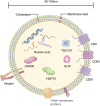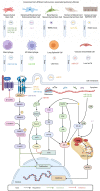Exosomes in pathogenesis, diagnosis, and treatment of pulmonary fibrosis
- PMID: 36091791
- PMCID: PMC9453030
- DOI: 10.3389/fphar.2022.927653
Exosomes in pathogenesis, diagnosis, and treatment of pulmonary fibrosis
Abstract
Pulmonary fibrosis (PF) is a group of interstitial lung diseases that seriously endanger human life and health. Despite the current advances in research on the pathogenesis and treatment of PF, the overall quality of survival and survival rates of PF patients remain low, prompting the search for more effective therapeutic approaches. Exosomes are nanoscale vesicles with diameters ranging from approximately 30-150 nm, capable of transporting a variety of molecules in the body and mediating intercellular communication. There is an increasing number of studies focusing on the role of exosomes in PF. This review demonstrates the significance of exosomes in the pathogenesis, diagnosis, and treatment of PF. Exosomes are able to influence inflammatory, immune, and extracellular matrix deposition processes in PF and regulate the corresponding cytokines. Some exosomes detected in sputum, blood, and bronchoalveolar lavage fluid may be used as potential diagnostic and prognostic biomarkers for PF. Exosomes derived from several cells, such as mesenchymal stem cells, have demonstrated potential as PF therapeutic agents. Drug delivery systems using exosomes may also provide new insights into PF therapy.
Keywords: biomarkers; exosomes; pathogenesis; pulmonary fibrosis; therapeutics.
Copyright © 2022 Yang, Liu, Chai, Liu, Hu, Zhao, Zhu, Gao, Huang and Zhang.
Conflict of interest statement
The authors declare that the research was conducted in the absence of any commercial or financial relationships that could be construed as a potential conflict of interest.
Figures




Similar articles
-
Exosomal MicroRNA: Diagnostic Marker and Therapeutic Tool for Lung Diseases.Curr Pharm Des. 2021;27(26):2934-2942. doi: 10.2174/1381612827666210608150640. Curr Pharm Des. 2021. PMID: 34102963
-
Emerging delivery approaches for targeted pulmonary fibrosis treatment.Adv Drug Deliv Rev. 2024 Jan;204:115147. doi: 10.1016/j.addr.2023.115147. Epub 2023 Dec 6. Adv Drug Deliv Rev. 2024. PMID: 38065244 Free PMC article. Review.
-
Mechanism of miR-204-5p in exosomes derived from bronchoalveolar lavage fluid on the progression of pulmonary fibrosis via AP1S2.Ann Transl Med. 2021 Jul;9(13):1068. doi: 10.21037/atm-20-8033. Ann Transl Med. 2021. PMID: 34422980 Free PMC article.
-
Human pluripotent stem cell-derived macrophages and macrophage-derived exosomes: therapeutic potential in pulmonary fibrosis.Stem Cell Res Ther. 2022 Sep 2;13(1):433. doi: 10.1186/s13287-022-03136-z. Stem Cell Res Ther. 2022. PMID: 36056418 Free PMC article. Review.
-
Roles of exosomes and exosome-derived miRNAs in pulmonary fibrosis.Front Pharmacol. 2022 Aug 11;13:928933. doi: 10.3389/fphar.2022.928933. eCollection 2022. Front Pharmacol. 2022. PMID: 36034858 Free PMC article. Review.
Cited by
-
The bronchoalveolar lavage fluid CD44 as a marker for pulmonary fibrosis in diffuse parenchymal lung diseases.Front Immunol. 2025 Jan 13;15:1479458. doi: 10.3389/fimmu.2024.1479458. eCollection 2024. Front Immunol. 2025. PMID: 39872532 Free PMC article.
-
Progress in understanding and treating idiopathic pulmonary fibrosis: recent insights and emerging therapies.Front Pharmacol. 2023 Aug 7;14:1205948. doi: 10.3389/fphar.2023.1205948. eCollection 2023. Front Pharmacol. 2023. PMID: 37608885 Free PMC article. Review.
-
Molecular monitoring of lung allograft health: is it ready for routine clinical use?Eur Respir Rev. 2023 Nov 22;32(170):230125. doi: 10.1183/16000617.0125-2023. Print 2023 Dec 31. Eur Respir Rev. 2023. PMID: 37993125 Free PMC article. Review.
-
Exosomal miRNAs as biomarkers and therapeutic targets in silicosis-related lung fibrosis.Mol Biol Rep. 2025 Jun 12;52(1):585. doi: 10.1007/s11033-025-10687-w. Mol Biol Rep. 2025. PMID: 40504442 Free PMC article. Review.
-
Epithelial Cell Dysfunction in Pulmonary Fibrosis: Mechanisms, Interactions, and Emerging Therapeutic Targets.Pharmaceuticals (Basel). 2025 May 28;18(6):812. doi: 10.3390/ph18060812. Pharmaceuticals (Basel). 2025. PMID: 40573209 Free PMC article. Review.
References
Publication types
LinkOut - more resources
Full Text Sources

